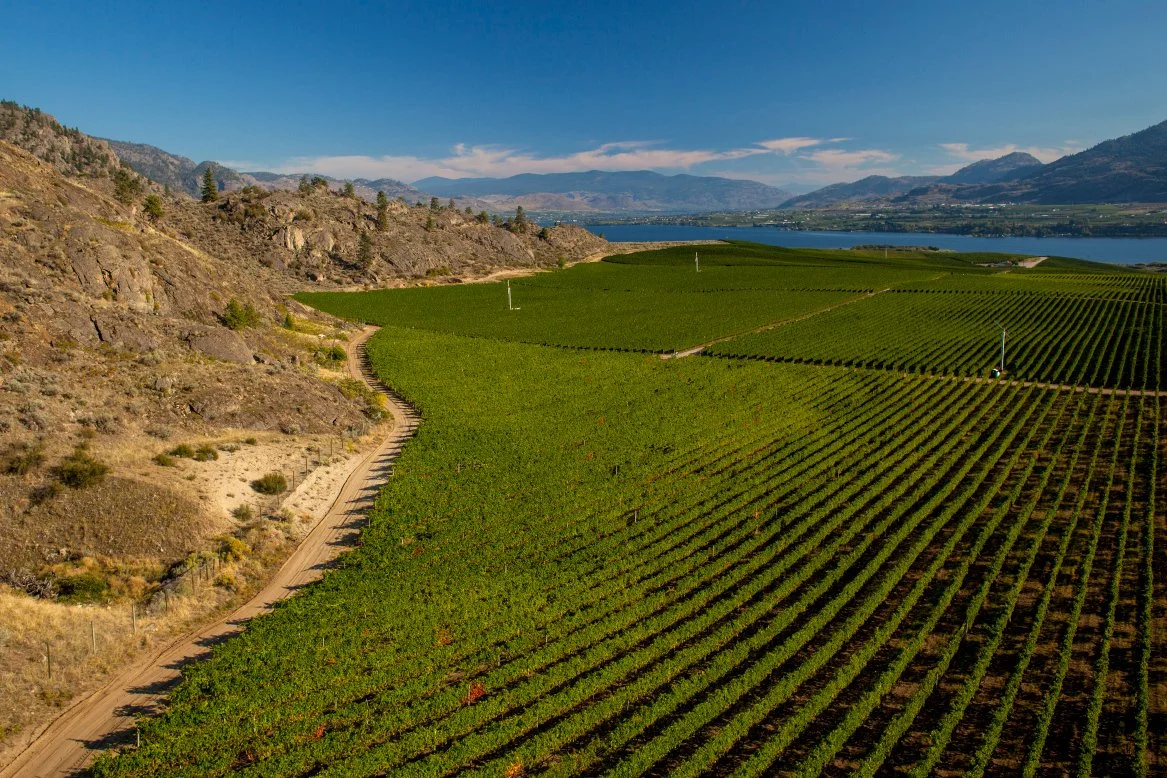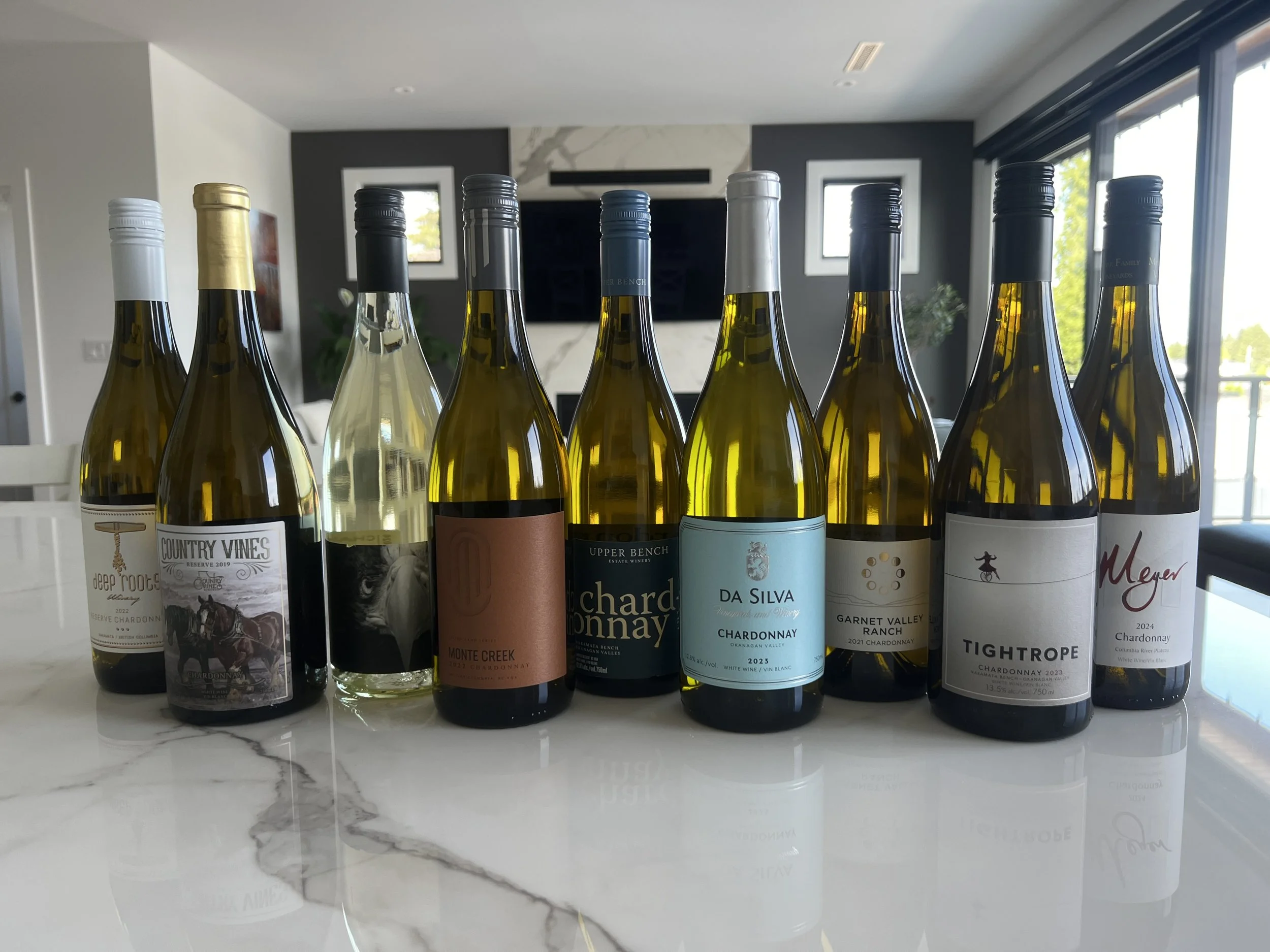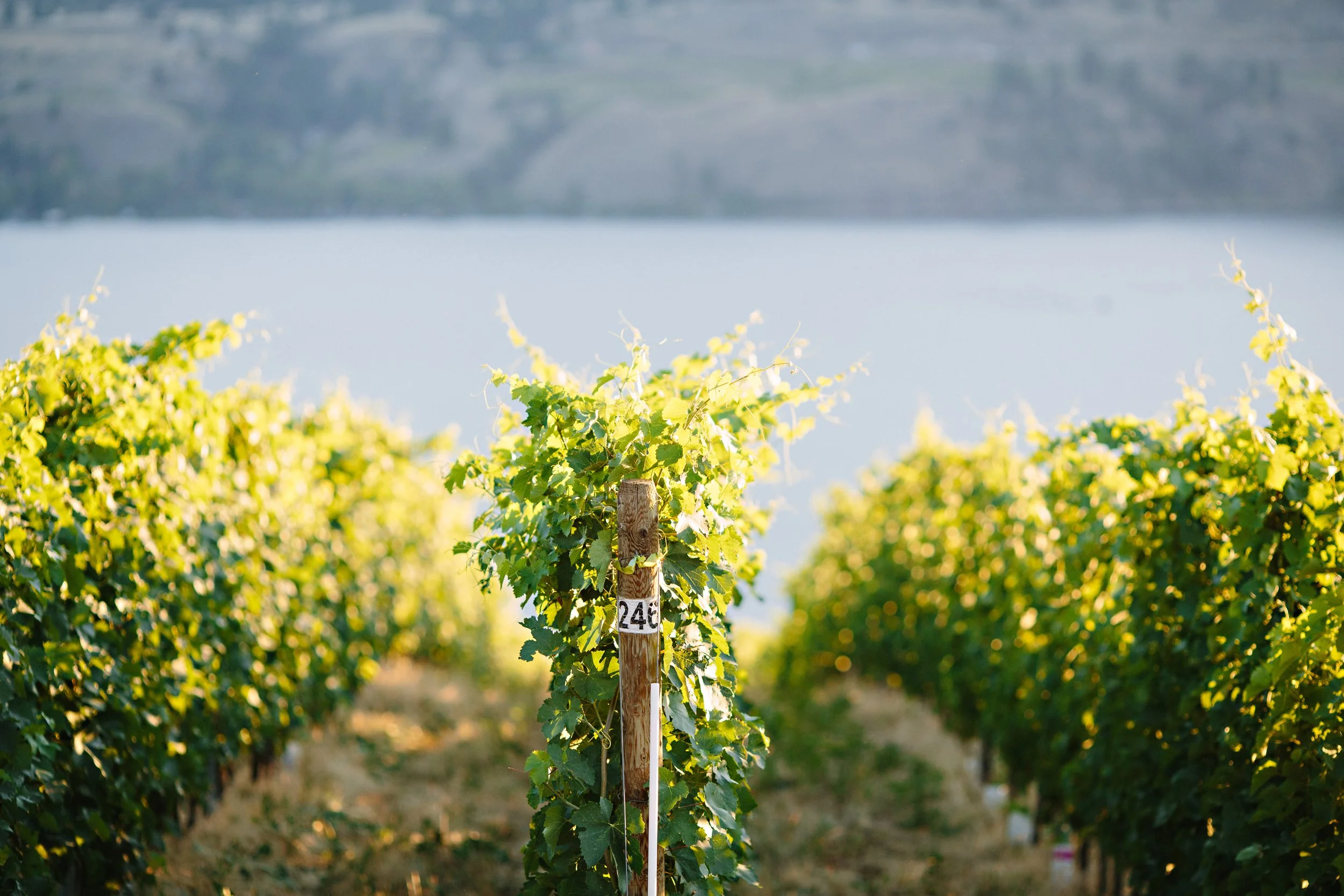Best of BC Chardonnay
Photo credit: Wines of British Columbia
It thrills me to shine a spotlight on today’s celebrated wine grape. Responsible for some of the cheapest and most expensive wines in the world, it can range from dreadfully uninteresting to divinely expressive. Everyone knows it, and everyone’s got an opinion about it. There’s no shortage of controversy and strong feelings about this one, so let’s dive in with a spirit of discovery and openness.
It sits at 2nd place among white wine grapes planted in BC, with 22% of the acreage. It cracks the top 4 planted varieties in all except the hottest and wettest regions of BC. So, yeah, we’re talking big league. Equally treasured and embraced as a single-varietal, blend, or sparkling wine - this is none other than the OG from Burgundy: Chardonnay.
I can already hear the reactions. “Mmm I love a good Chardonnay,” is one. Another sounds something like, “Um no thanks, what else do you have?” Lovers love it, and haters hate it. The reasons for this are explored in Part 2 (link) on this blog. But like it or not, Chardonnay is here to stay. It’s essential for any wine-producing region that can provide the necessary cooler climate conditions in which this vine thrives. More so than any other, this grape is a blank slate. Remarkably unremarkable, actually. But it’s this highly malleable quality, a propensity for accepting influence, that sets Chardonnay apart for better and for worse.
All white wines, whether still or sparkling, need a dependable blending partner. Chardonnay saves the day. Wineries need a reliable and versatile grape that keeps the lights on. Again, Chardonnay saves the day. Producers who want to showcase their unique terroir, enviable soils, winemaking prowess, or barrel budget - again, Chardonnay - you guessed it. Let’s just break it down and set aside the fluff. Chardonnay is like any other wine. It’s an expression of the fruit, how and where it was grown, and the hands that transformed it. When you look at it this way, you can appreciate the variation and diversity of this most famous wine grape, and that’s what we’re here to do.
Now I did allude that this is a rather bland grape. However it can’t be said to have no character at all. It is capable of bringing high acidity, very useful for production of sparkling wines and crisp still wines like the style of Chablis. High acidity also gives winemakers the substrate to allow malolactic fermentation if they so choose. This softens the sharp edge and leaves a slippery, smooth texture and allows the creamier lactic acid to tug at your cheeks and gums long after your sip. Aromas are usually delicate citrus and green apple, but can vary from region to region and vineyard to vineyard. Wines of this style are more likely to come from sites on the west side of Okanagan Lake, Kelowna, Lake Country, Okanagan Falls, and Vancouver Island. If warmer conditions allow more advanced ripening, exotic essences of peach, pineapple, or banana emerge. You may find this kind of Chardonnay coming from sites on the eastern side of Okanagan Valley like the Naramata bench, Skaha Bench, or Oliver and Osoyoos.
If you’re apprehensive of selecting a Chardonnay from a wine list or tasting bar, I don’t blame you. You don’t always know what you’re going to get. You might know that different regions have a certain style, whether it’s Burgundy, New Zealand, or Napa. But since Chardonnay can run the gamut in BC, it’s worth asking your server or tasting room associate a few questions, since they know best and are there to help! We all want to have positive experiences with wine. Even if I don’t like a wine I try, I have learned something and expanded my knowledge by one more wine and I consider that a positive experience.
Try one of the excellent Chardonnays from BC below, which were provided by the producers for this feature. While it’s an important blending partner, these are all 100% Chardonnay (and 100% delish). I would recommend enjoying these just lightly chilled to give all the intricacies opportunity to be appreciated. Note that due to BC’s crop loss in 2024, some wines were crafted in BC with Washington grapes.
I’ve divided these wines into two categories representing two styles: light and crisp, vs ripe and rich. There’s something for everyone here, and your own preference will guide you right.
Light and Crisp
Winemakers CUT 2024 Chardonnay | Yakima Valley AVA, Washington
A variation on a theme, this Chardonnay was given 3 hours skin contact before fermenting entirely in neutral oak, and aging 5 months in stainless steel. The nose carries lemon, apple, and yellow plum with a footnote of crushed rock, which will please those accustomed to the mineral complexity of BC Chardonnay. The palate is soft and juicy, with a subtle richness and whispers of vanilla and spice. Another friendly addition to the winemaker’s story of this vintage.
Meyer 2024 Chardonnay | Yakima Valley AVA, Washington
Chardonnay from Newhouse Vineyard was pressed, and the juice transported to Okanagan Falls for fermentation in stainless steel vats. The wine is aged 6 months in neutral French oak and sees complete malolactic conversion. Apple, lemon, white blossoms, cardamom cracker, and juicy kiwi aromas characterize the nose, the tropical fruit notes hinting at a more southern growing region. The palate is characterized by crisp citrus acidity, a tropical and floral persuasion, and a light toasty finish. Approachably nonchalant.
Fort Berens 2024 Chardonnay | White Bluffs AVA, Washington
Harvested and fermented on site in Washington at the hand of Fort Berens’ Assistant Winemaker Seth Jex, this Chardonnay was divided into two batches for aging back in Lillooet: 30% in French oak for 4 months, 70% on lees in steel tanks. Both batches were blended together prior to bottling. Bright, fresh, and fruity is the theme. Notes of apple, lemon, pear, star fruit, and toast on the nose with a gravelly vein. Tart fruit flavours and a nice gentle toastiness, light on lees, make for a pleasing and casual finish. Lively and uncomplicated.
Two vineyards near Penticton provided the Chardonnay, which was crushed and stainless steel fermented followed by 8 weeks barrel aging in new American oak. There is a delicate fruit-and-floral personality with subtle melon, grapefruit, honeysuckle, and thistle on the nose. Not at all weighed down by wood, the palate is effortlessly light and fresh, tart citrus fruit facilitating a crisp finish that begs for more.
Fruit from Four Shadows Vineyard on the Naramata bench is whole cluster pressed and fermented in 100% French oak, and aged on lees for 9 months. Half the wine undergoes malolactic conversion. A very fresh introduction of apple, lemon, pear, carnation, and lightly buttered toast is followed by a second impression on the palate: zippy citrus, delicate balance, and a very gracile, restrained expression. A toasty finish completes the highwire act.
Ripe and Rich
Domaine Artema 2023 Chardonnay
This Cru-level Chardonnay from newly founded Domaine Artema on the Black Sage Bench is whole cluster pressed, then fermented and aged in 89% neutral French oak and 11% stainless with batonnage once a week. Full malolactic conversion was allowed. Medium lemon yellow in colour, this wine releases aromas of lemon cream, juicy tart citrus, and plenty of buttery biscuits. ‘Going full malo’ has sacrificed some freshness, but the texture is soft and round, and gives you what you expect for a south Okanagan Chardonnay - ripe and sunny.
(Okanagan Crush Pad) | Garnet Valley Ranch 2021 Chardonnay
Grapes from high up on their organic Summerland estate are whole cluster pressed, fermented in concrete, and aged in both concrete and stainless. This has crazy concentration and character, and a distinctly muscular, robust style. Without any oak influence, the nose is dominated by fruit and savoury elements of apple compote, lemon zest, pear, hay, cantaloupe, rosehip bush, and smoky salts. Great texture, with some malo present (adding sourdough and whipped butter), and luscious acidity that elevates the charred peach and earthiness on the palate. A magical Chardonnay with a sense of place.
Country Vines 2019 Chardonnay Reserve | (Bronze, National Wine Awards of Canada)
Sourced from Keremeos, this Chardonnay is made in Richmond and aged in French oak with malolactic conversion. Intense fresh lemon juice and zest, dill, nutmeg and cloves, grilled pineapple, and coconut lemon crème brûlée fill the generous but bright and lifted nose. Smooth, buttery texture is apparent but the palate is still fresh and the extended, toasty finish combines fresh and dried citrus and spices. Decadent and concentrated, and still comfortably in its drinking window.
Half barrel-aged in French oak for 3 months (30% new barrels), and half in stainless steel. The attack is not subtle, but it’s balanced and exciting, so who cares? Intense aromas of lemon peel, sabayon, some peach and pineapple, daisies, and toasted spices are well supported by energetic ripe acidity, vibrant freshness and texture, and a lengthy close. Apparently you can have it all - this one is hard to beat.
Deep Roots 2022 Reserve Chardonnay | (Bronze, National Wine Awards of Canada)
A small production (144 cases) from Chardonnay grown on their Hardman vineyard on the Naramata bench, whole cluster pressed, and fermented in new French oak. The wine is aged 6 months on the lees and goes through malolactic conversion. Buttery lemon rind, stone fruit, toasted nuts, and vanilla embellish the nose and palate with a satisfying intensity. The long, lactic finish clings in the best way. A juicy, mouthwatering, and flashy expression.
Monte Creek 2022 Living Land Chardonnay | (Gold, National Wine Awards of Canada)
Wild fermentation is followed by aging sur lie in 25% concrete eggs and 75% French oak. Flying the flag for ‘New-Wave’ Chardonnay in BC, this wine combines ripeness, concentration, and elegant freshness. Layers of apple, lemon, pear, toast, citrus peel, hot sauna rocks, and spice dance on the nose and palate. Flavour and structure interweave and crescendo. But the true quality is revealed in the complex, balanced finish. There is power in restraint.
Photo credit: Wines of British Columbia, Jon Adrian
There is exceptional Chardonnay coming out of BC and I dare say it is an under appreciated variety here. Sure we produce more Pinot Gris, Merlot, and Pinot Noir, but Chardonnay definitely has the most sex appeal among the white varieties and it’s just so useful to winemakers, and that alone deserves acknowledgement. Having said that, we can see the impressive devotion to quality as well as the colourful variation in expression on display. So if you’re a doubter, I beg you - don’t discard the Chard. Explore, ask questions, and search out what you love. I guarantee you’ll find it somewhere in a BC Chardonnay.
*Part 2 from 2024, goes into more detail about contrasting styles in BC, why some people don’t like Chardonnay and the reasons why, and food pairing guidelines.
This Blog Post was written by our contributor: Matt Tinney with MT Wine Consulting (@mtwineconsulting).




